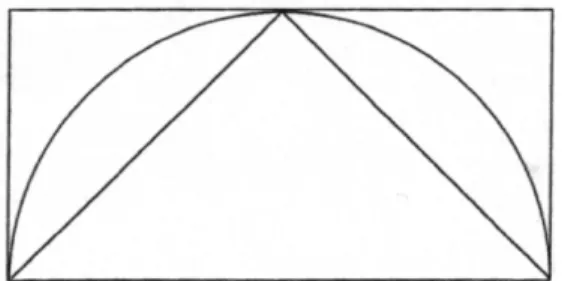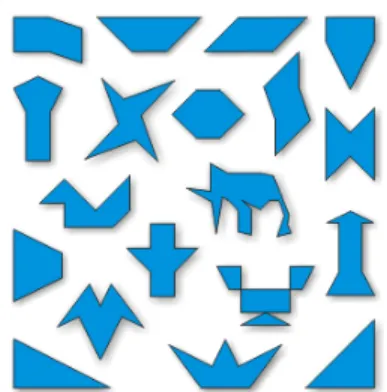HAL Id: hal-01349269
https://hal.archives-ouvertes.fr/hal-01349269
Submitted on 27 Jul 2016
HAL is a multi-disciplinary open access archive for the deposit and dissemination of sci-entific research documents, whether they are pub-lished or not. The documents may come from teaching and research institutions in France or abroad, or from public or private research centers.
L’archive ouverte pluridisciplinaire HAL, est destinée au dépôt et à la diffusion de documents scientifiques de niveau recherche, publiés ou non, émanant des établissements d’enseignement et de recherche français ou étrangers, des laboratoires publics ou privés.
Archimedes and visual reasoning – How a geometric
game led to combinatorics
George Booker
To cite this version:
George Booker. Archimedes and visual reasoning – How a geometric game led to combinatorics. History and Pedagogy of Mathematics, Jul 2016, Montpellier, France. �hal-01349269�
ARCHIMEDES AND VISUAL REASONING – HOW A
GEOMETRIC GAME LED TO COMBINATORICS
George BOOKER
Adjunct Lecturer, Griffith University, Nathan Qld 4111, Australia
george.booker@optusnet.com.au
ABSTRACT
An exploration of the Stomachion dissection puzzle provides an extension to the geometric activities schools introduce with tangrams, using the pieces to make shapes that were reported in the game that aroused Archimedes attention. The puzzle can also be used to investigate rotations, symmetry, reflections, angles and areas. Replacing the pieces into the square in which they are contained leads to a discussion of the different ways that this can be done, the problem that Archimedes investigated. A concluding discussion will focus on the combinatorial analysis of this, drawing on research that accompanied the decoding of the Archimedes Codex.
1 Archimedes
Archimedes was the greatest mathematician of the ancient world, one of the greatest thinkers who ever lived. He approximated the value of π, developed the theory of centres of gravity, and (used this) to make steps towards the development of the calculus. (Netz & Noel, 2007
Archimedes was born, lived his life and died in Syracuse at the time the most powerful city-state in the Mediterranean. Through visits to Alexandria he came into contact with the Euclideans and Eratosthenes, the director of the famous library at that time, and kept up a continuous series of letters to these mathematicians that provide glimpses into his ways of working (Arkimedeion catalogue, 2011). Unfortunately killed in 212 BCE during a battle with Roman forces, his work known as the method led to two guiding principles for modern mathematics and science:
• the mathematics of infinity
• the application of mathematical models to the real world
Indeed, Galileo, Liebniz, Huygens, Fermat, Descartes and Newton all drew on these principles and Archimedes ways of working in a theoretical light, using the method of indirect proof or proof by induction and contradiction. His analysis of conic sections, spheres and cylinders, squaring the circle and parabola as well his practical inventions such as the Archimedes screw and the uses of parabolic mirrors are remarkably well illustrated in an interactive museum, the Arkimedeion, opened in Syracuse in 2011.
However, one aspect of his work is only hinted at there – his investigation of a 14 piece puzzle known as the Stomachion. Only recently has the mathematics behind his interest come to light in the painstaking uncovering of the palimpsest now known as the Archimedes Codex. An investigation of this puzzle and the way in which it led to profound mathematical thinking will be the focus of this presentation.
1.1 Visual reasoning
Archimedes thinking relied on the visual, using schematic diagrams that represent topological features of a geometrical object. In this, ideas and arguments are as well represented by a diagram as they are by language or equations, forming a valid part of the argument used in the mathematics of Archimedes time without the danger of errors based on visual evidence (Netz & Noel, 2007, p. 104).
In the method as it has been known and accepted for a long time, Archimedes used a notion of ‘potential infinity’ which avoided consideration of actual infinity utilised since the 19th century. A match between lines representing cuts in shapes such as parabolas, spheres and cylinders (Berggren, 2008) were made as big or as small as wanted, and the same thinking applied to any left over sections indefinitely, thus exhausting all the possibilities without referring to an actual notion of infinity. In this way, ratios among the lines could be determined, and lead to similar relationships among the shapes represented among the lines ‘contained’ within them. In particular, combining principles of mathematics and physics, Archimedes was able to reason that if a cone was contained in a hemishere which in turn was enclosed in a right circular cylinder, then the volume of the three solids are in the ratio 1:2:3 (Swetz, 1994, p. 180). In turn, this result led him to determine the volume of a sphere by considering a cylinder that would just enclose the sphere – the volume of the sphere was 2 thirds of the volume of the cylinder (in our terms, 4/3πr3 ).
Figure 1. Slice of a cone, hemishere and cylinder used by Archimedes
However, the surprise in store for Noel along with his colleague Saito as they deciphered more of the lost codex was that Archimedes had gone beyond his original method to look at reults that were equal in magnitude. In other words, he had set up a one to one correspondence between the two infinite sets of magnitudes that he used, the same manner as the concept was structured in the 19th Century when set theory and the calculus were at last put on a firm foundation.
2 Stomachion
When the first, incomplete attempt to decipher Codex C, now known as the Archimedes Codex, by the philologist Heiberg in the early 1900s, the section relating to the Stomachion puzzle was not able to be read and the writing largely ignored. It was thought that Archimedes might be trying to determine the number of ways a particular shape might be made using some of the 14 pieces that made up the puzzle, but this seemed a curious past time, not a mathematical pursuit (most shapes could be made in many ways, perhaps an unlimited number of arrangements)
.
One of the most interesting shapes presented in Figure 2 above is the elephant which was probably the most popular among the Roman citizens at least who took up a keen interest in the puzzle. Not only was the shape an engaging one to construct, the fact that Syracuse had switched its alliance to Carthage from Rome, perhaps believing that Hannibal with his elephants that had come so close to conquering Rome was to be the new dominant power in the Mediterranean. Unfortunately, as Archimedes found to the cost of his own life, neither the power of the Carthiginians nor the formidable weapons constructed under his instruction and knowledge of mechanics was sufficient to keep the Roman army under Marcellus from taking Syracuse.
Figure 2. Arrangements that can be formed using some or all of the 14 Stomachion pieces (NCTM Illuminations, 2015)
Other investigations can be made with the puzzle. For instance it has been observed that when the puzzle is formed on a grid, the vertices of all pieces meet on the intersection of the vertical and horizontal lines which then gives rise to the area of each piece:
Figure 3. These can be further sinplified by noting each is a multiple of 3 (Archimedes Square, Kadon, 2004).
It is perhaps this unique construction among dissection puzzles that led to Archimedes interest in the geometric properties inherent in it.
2.1 Playing with the Stomachion puzzle
Figure 4. Examples by Pitici (2008)
After using the pieces to make different shapes, it is time to put them away and this is where we now know that Archimees became very interested in the problem this presents. It turns out that the pieces can be packed back into the original square in a great many different ways although this is indeed a finite number. There is as yet no report of the result that Archimedes found but the investigators of the Archimedes Palimpsest set a problem to mathematicians to solve and a total of 17 153 possibilities were determined, but when rotations and reflections were considered, this reduced to 536 unique solutions found by Bill Cutler a PhD graduate from Cornell University who set up a computer model to determine the result.
Figure 5. Some of the arrangements made by Cutler (2004)
This result was found independently by Fan Chang and her husband Ron Graham, mathematicians who used complex model theory for their result. They also noted that 3 pairs had to be always placed together, thus reducing the puzzle to one with a smaller number of pieces they called a stomach (Fan Chang & Graham, 2004)
While the determination of the number of possibilities is a problem for mathematicians working in the field of graph theory, it could be used as a motivation to explore combinatorics among students of all ages and provide colour and interest to a topic that often seems simply an application of number ideas.
REFERENCES
Arkimedeon Catalogue (2011). The keys to the thinking of Archimedes. Mannelli, Italy: Editinera.
Berggen, J. L. (2008). Book Review: The Archimedes Codex. Notices of the American Mathematical Society,
September, 943-947.
Fan Chang, & Graham R. (2004). A tour of Archimedes’ Stomachion. Retrieved in June 20 2016 from www.math.ucsd.edu/~fan/stomach/tour/dis.html
Kadon Enterprises (2004). The life of games Issue no 3, see Archimedes Square.Retrieved in June 20 2016 from http://www.gamepuzzles.com/
Netz, R., & Noel, W. (2007). The Archimedes Codex. London, UK: Weidenfeld & Nicolson. Pitici, M. (2008). Geometric Dissections: Archimedes Stomachion. Retrived in June 20 2016 from
Swetz, F. (Ed) (1994). From five fingers to infinity: A journey through the history of mathematics. Peru, IL: Open Court.
Zordak, S. (2015). Archimedes Puzzle. NCTM Illuminations October. Reston, VA: National Council of Teachers of Mathematics.
ENDNOTE. A fascinating account of the unravelling of the Archimedes Codex presented by Willian Noel can be
viewed at: www.ted.com/talks/william_noel_revealing_the_lost_codex_of_archimedes?language=en Retrieved in June 20 2016


